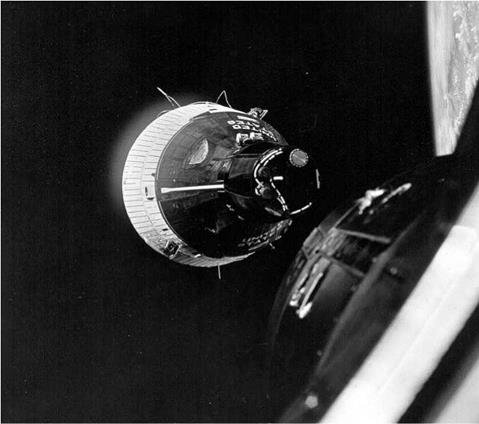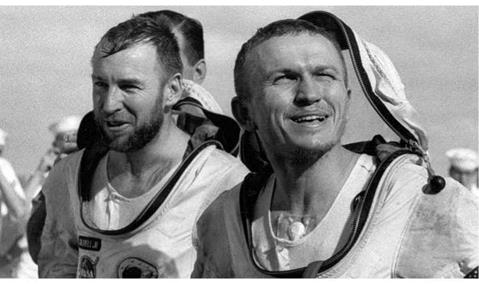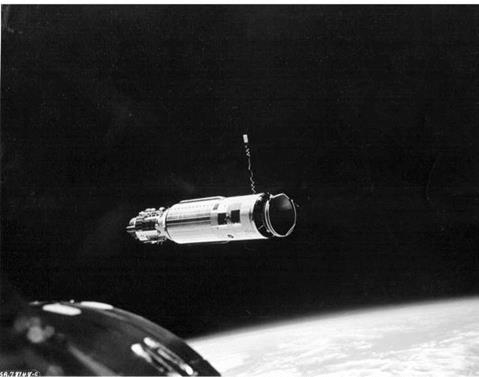AND 6A
|
Int. Designation |
1965-100A (Gemini 7); 1965-104A (Gemini 6A) |
|
Launched |
4 and 15 December 1965 |
|
Launch Site |
Pad 19, Cape Kennedy, Florida |
|
Landed |
16 December 1965 |
|
Landing Site |
Both spacecraft splashed down in the western Atlantic |
|
Launch Vehicle |
Titan II GLV No. 7 (Gemini 7) and GLV No. 6 (Gemini 6A); spacecraft serial number 7 (Gemini 7) and 6 (Gemini 6A) |
|
Duration |
13 days 18 hrs 35 min 1 sec (Gemini 7); 1 day 1 hr 51 min 54 sec (Gemini 6A) |
|
Callsign |
Gemini Seven; Gemini Six |
|
Objective |
Fourteen-day extended-duration mission (Gemini 7); first space rendezvous (Gemini 6A with Gemini 7) |
Flight Crew
BORMAN, Frank, 37, USAF, command pilot Gemini 7
LOVELL, James Arthur Jr., 37, USN, pilot Gemini 7
SCHIRRA, Walter Marty Jr., 42, USN, command pilot Gemini 6A, 2nd
mission
Previous mission: Mercury-Atlas 8 (1962)
STAFFORD, Thomas Patten Jr., 35, USAF, pilot Gemini 6A
Flight Log
NASA continued its pre-Apollo rehearsals with plans for Gemini 6 to perform the first docking in space and then for Gemini 7 to keep two men “in the can” for 14 days. The first objective was to be met on 25 October 1965 when an Atlas Agena was to place the Agena second stage (housing a docking port and a rendezvous radar antenna) in orbit as a target for Gemini 6, which would be launched 90 minutes later. With astronauts Wally Schirra and Tom Stafford already in Gemini 6 at Pad 19, the Atlas thundered away from Pad 14, but the Agena exploded and the frustrated astronauts were grounded. NASA hatched a plan to overcome the setback. They would launch Gemini 7 first, on Gemini 6’s original Titan, then launch Gemini 6 to rendezvous with Gemini 7. The plan was announced by President Johnson himself, the space supporter who had persuaded President Kennedy to shoot for the Moon.
So first Gemini 7 – with crewmen Frank Borman and James Lovell looking like aliens in their lightweight, 8 kg (18 lb) spacesuits, with strange hoods rather than helmets – took off at 14: 30 hrs on Saturday 4 December, sharing US television screens with a football match. The astronauts entered a 28.9° inclination orbit with a maximum altitude of 327 km (203 miles) and sat it out in the tight confines, waiting
|
Gemini 6 photographed from Gemini 7 |
for Gemini 6 to be launched on 12 December. Lovell was allowed to take off his spacesuit, while Borman had to endure the flight with electrodes fixed to his head and suffer the indignity of bursting his urine bag after filling it, rather than before. Contrary to the media coverage, pioneering space flight was an endurance, not a picnic.
The Gemini 6 astronauts had a new experience to endure on 12 December, when at 09:54 hrs local time their Titan II ignited, only to shut down 1.2 seconds later when a dust cap left in a gas generator caused imperfect combustion. This was spotted by the malfunction detection system. Although the spacecraft clock had started, Schirra knew instinctively that he had not lifted off. He elected not to pull the ejection lever, which would have subjected him and Stafford to a 20-G ride, killing the rendezvous mission and probably crippling them. Stafford had been to the launch pad twice and had not lifted off. However, at 08:37 hrs on 15 December, he finally did so, and the space chase was on. Gemini 6 entered an 8.9° orbit which would reach a maximum apogee of 311 km (193 miles).
|
Lovell (left) and Borman look tired but happy after their 14-day marathon flight |
Seven very carefully planned and controlled manoeuvres brought Gemini 6 to within 15 cm (6 in) of Gemini 7. Officially, the rendezvous had been achieved at 14:33hrs Cape time. It was the greatest feat in manned space flight so far, and the media coverage epitomised the excitement of the 1960s space race. Five hours 18 minutes and a lot of good natured bantering (and a seasonal “Jingle Bells” from Schirra and Stafford) later, Gemini 6 backed away and made a landing at T + 1 day 1 hour 51 minutes 54 seconds, just 11.2km (7 miles) from USS Wasp. Borman and Lovell continued their endurance flight and the operation of 18 science experiments, finally landing 10.4 km (6 miles) from the USS Wasp at T + 13 days 18 hours 35 minutes 1 second. This is the longest US two-crew space flight. They were light-headed and stooping as they walked across the carrier deck, but had proved beyond a doubt that man had a place in space.
Milestones
18th and 19th manned space flights 10th and 11th US manned space flights 4th and 5th Gemini manned flights 1st space rendezvous 1st flight cancellation (Gemini 6)
1st launch pad abort (Gemini 6A)
1st four-man joint mission

 |
Flight Crew
ARMSTRONG, Neil Alden, 35, civilian, command pilot SCOTT, David Randolph, 34, USAF, pilot
Flight Log
The first space docking was on the agenda for Gemini 8, and Scott was to make a two-hour spacewalk “around the world” at the end of a 28 m (92 ft) tether and attached to a 42 kg (93 lb) Extravehicular Support Package. The crew had been inside Gemini 8 for 14 minutes when the Agena target thundered away from Pad 14. Their own launch came at 10: 41 hrs local time, although the Titan II seemed a bit sluggish to start with. Perfect orbit was achieved, with a 28.9° inclination and an apogee-perigee of 292-160 km (181-99 miles). The Agena was 1,963 km (1,220 miles) away and the space chase began. It ended with a “real smoothie” of a docking, as Armstrong described it, at T + 6 hours 32 minutes and at a speed of about 8 cm (3 in) per second.
The matter-of-fact docking complete, the first US space emergency then began in a rather insidious manner. First, the two spacecraft rolled 30° out of position and the crew thought that the Agena, which was causing some concern on the ground anyway, was at fault. They disengaged its control system and brought the two craft under control using Gemini’s thrusters. Suddenly, a faster roll developed and the crew decided to separate from the Agena barely 27 minutes after docking, backing away as they did with a short burst of the thrusters. Then things got pretty violent. Gemini went into a 70 rpm roll and yaw combined, and the crew came close to their physiological limits. Thruster 8 had short-circuited and was firing intermittently, the crew discovered later. There was only one thing to do, which was to cut off the OAMS thrusters and fire the re-entry control system.
Mission rules dictated an emergency return to Earth and Gemini 8 splashed down about 800 km (497 miles) east of Okinawa at T + 10 hours 41 minutes 26 seconds, glad to have made water and not a remote jungle. After an uncomfortable three-hour wait, the crew was met by the USS Leonard F. Mason and they climbed aboard from the
|
Gemini 8 approaches the Agena docking target |
rolling sea up a Jacob’s ladder. Both astronauts would have another ladder later in their careers, this time to step down, as Gemini 8 was the only flight whose crew members both subsequently walked on the Moon.
Milestones
20th manned space flight 12th US manned space flight 6th Gemini manned flight 1st space docking 1st emergency return to Earth













